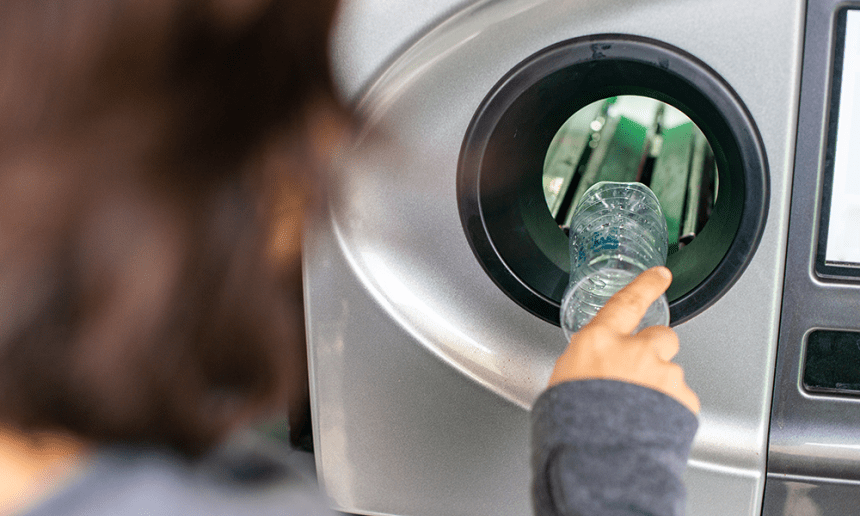
Members of the recent Circular Economy Institute (CEI) roundtable were asked an important question: how does the language we use help or hinder our efforts to be more circular with resources and waste?
The latest Circular Economy Institute roundtable discussion – which took place alongside CEI’s Festival of Circular Economy 2025 and was sponsored by VEV – was called ‘Simplifying language and “selling the sizzle” of the circular economy’. The aim was to take a step back and look at the vocabulary we use to talk about circularity. Can our language be simpler? Could our choice of words be better? And what difference could this make?
The session’s facilitator was circularity expert Mark Shayler, who neatly summed up the importance of selecting the right language at the beginning of the session with an anecdote: ‘I was running a workshop a few weeks ago,’ he recalled.
‘On the panel with me were four young women who were there to talk about the future of fashion. They were asked if they bought fast fashion from the likes of Shein, and of course they said “yes” – they’re cash-strapped and fashion-curious. But then they were asked “do you buy secondhand clothes?”. They all went “Urgh! No!”. Then we asked them, “do you like vintage?” – and they said, “Oh yes, we love vintage. Vinted is our new best friend”.’
Shayler’s point is a good one: when it comes to changing minds, habits and behaviours, it’s not just about what we say, it’s about how we say it. Those who work in marketing know this well – hence the title of the roundtable. ‘Sell the sizzle, not the sausage’ has long been a mantra of the advertising industry.
Posh recycling
The aim of the session was to simplify language – to pull more people towards the circular economy and give it its own centre of gravity. But how do we change our vocabulary to strengthen the story? Do we listen to how people already interpret complex specialist terms (‘the circular economy; oh that’s just posh recycling isn’t it?’) or do we seize the narrative and change the messages we put out?
Trewin Restorick suggested that environmentalists can be very good at coming up with phrases that are hard to understand, and that, in doing so, they leave themselves open to alternative interpretations that can be used in negative ways.
‘“Net zero” is a classic example,’ he said. ‘It’s become an attack weapon for those who are against sustainability policies. Those people can use any definition of the phrase “net zero” that they want, because it’s not clearly understandable by the average person on the street.
The way we talk about net zero is becoming separated from climate change.
‘“15-minute cities” is another one. Those who oppose this idea have interpreted this as “you can’t drive your car out of your own city”, which is complete rubbish. But it’s used as an attack weapon. So my concern with the phrase “circular economy” is that someone will say, at some point, “this is so vague; I can use it as an attack weapon”.’
Restorick asked why we need these terms at all. ‘Why don’t we just show by example, or explain things in terms of “this is going to save you money” or “this is going to grow the economy”?’
Signe Norberg, from the Aldersgate Group, added that the ‘why’ is very important to connect fractured concepts. ‘The way we talk about net zero is becoming separated from climate change. Net zero is a scientific term – it’s what we need to achieve in order to prevent a tipping point. But climate change is the “why” – it’s the whole point of net zero, and it’s not being talked about in the same way as net zero. Research shows that the media is reporting them as separate things.’
Fiona Charnley agreed: ‘I find the phrase “circular economy” easier to communicate than the word “sustainability”, which I think scares people because it’s so broad and wide ranging.’
‘To me, the crucial audience is the policy-makers and the influencers,’ said CIWM’s Dan Cooke. ‘The wider public – to a large extent, and without being patronising – take care of themselves. You just give them clear instructions.
To me [Dan Cooke], the crucial audience is the policy-makers and the influencers
‘Make it clear and easy and most people will do it; you can mop up the minority. But selling the sizzle of this to the policy-makers requires us to explain why it’s important in language they will understand and want to hear: it will create more jobs, it will create growth, it will reduce the risk of pollution and climate chaos.’
Claire Shrewsbury asked if we were considering the importance of accessibility and equity: ‘How do we make this new circular world accessible for all, so it’s not just the elite who can do it? WRAP is a supporter of [the bike rental scheme] Bike Club – which is all lovely – but the scheme is run through John Lewis and you have to pass a credit check to be part of it.
‘If you’re living in a high-rise with three kids and no income, then you’re not going to be a part of that scheme. So how do we open up initiatives like that to a broader, more diverse audience?’
 Circular editor (pictured above) Ian Farrell agreed: ‘Is it a case of priorities? If you are living in that high-rise and you’re struggling, then maybe the problems that keep you awake at night are not going to be to do with the environment. Other things are more important and more immediate.’
Circular editor (pictured above) Ian Farrell agreed: ‘Is it a case of priorities? If you are living in that high-rise and you’re struggling, then maybe the problems that keep you awake at night are not going to be to do with the environment. Other things are more important and more immediate.’
Restorick suggested that the potential for circular initiatives to be local and ‘tug on heart strings’ was enormous, and the language used to describe them needed to reflect this. He mentioned Hubbub’s successful campaign to collect old mobile phones during the Covid-19 pandemic, and redistribute them to people in the same community who didn’t have internet access.
‘When people realised they could help someone in their neighbourhood who was in dire need, the uptake was huge.
When people realised they could help someone in their neighbourhood who was in dire need, the uptake was huge.
‘Similarly, with our From a Mother to Another campaign, mums were asked to donate clothes to families in need in their area on Mother’s Day, and pin a note to them saying what this piece of clothing meant to them or their child. That emotional connection was so important.
‘But, crucially, none of this activity mentioned the circular economy, yet it did help people in a community by not throwing things away. The language focused on the emotional connection – that’s what people need to see the value in.’
Shayler agreed: ‘Yes, selling the output, not the thing. Do you remember the Battle of Atlanta campaign for Nike? A load of runners at the end of the Atlanta marathon, and it’s raining and they are all knackered. You can’t see any of the brands of the shoes and that’s OK: they aren’t selling the shoes; they are selling the feeling – the pride of having run a marathon.’
The task in hand

For the second half of the roundtable, participants were divided into three teams. Each team was asked to come up with language that sells the benefits of the circular economy to a specific demographic: team 1 was asked to pitch the circular economy to a large, fast-fashion textiles business; team 2 was tasked to consider how to communicate with the 40 to 59-year-old segment of the general public; and team 3 was asked to think about how to communicate with a non-Defra civil servant or policy-maker.
Team 1: Fast fashion
The team imagined they were talking to the CFO of a textile business with a global supply chain. Their pitch was fear-based: legislation is coming and your costs will go up if you stick with the business model you’ve got. But there are alternative ways of working – some proven, some untested – that can help. Think about leasing and subscription, which build brand loyalty, provide a regular income and ensure the resilience of your supply chain.
It was acknowledged by the group that this is one of the most difficult sectors with which to talk about circularity. ‘The industry is speeding up and that is how they make their money – cheaper, easier, quicker,’ said Restorick.
‘The only way that will change is if the rules of game change – and that’s external; that’s government. EPR [extended producer responsibility] will help, but it needs more than that. We’ve got to stop over-production.’
Team 2: Generation X
Talking with a 40 to 59-year-old demographic that is familiar with recycling at home, but has little other knowledge of sustainability, requires connectivity between actions, said team 2.
‘Recycling has become this kind of siloed activity in the home,’ said Dave Hughes, the UK commercial director of VEV. ‘Can we re-engage people and demonstrate there is a practical economic benefit to this? You’re not recycling waste; you’re placing a commodity back into the supply chain. Can we demonstrate how the benefit of this flows through the system, and people will get better, cheaper waste services as a result.’
Charnley found inspiration in a system from Germany, where stickers are awarded to products that have a certain amount of recyclable material, enabling consumers to make informed choices when shopping.
‘We thought about the phrase “made to be made again”, which could be adapted into things like “bought to be bought again” or “used to be used again”,’ she said.
Team 3: The policy machine
It was felt it was crucial to lead a government elevator pitch with the top-line benefit, not the details, said Cooke, summarising the findings of team 3.
‘Our elevator pitch would be something like: “The circular economy will help you come up with its missions and growth objectives. It will give you economic resilience and innovation, and create jobs (more of them), as well as boost productivity. It revitalises communities and supports cleaner energy security, and provides focus and opportunity for skills. There is an opportunity here for government to show leadership and vision… to embed policy principals across key sectors in the whole economy.”’
The next steps

In bringing the roundtable to a close, Shayler said that the discussion was very much the beginning of a process – the ideas would now be collected, tested, refined and developed.
‘We need to stress the benefits and joy that circularity can bring – the sizzle should be in abundance,’ he said.
‘The thing I’ve been left with is the need to move hearts and minds, as well as recycling and resources.’
Thanks to VEV for sponsoring this event.
The post Selling the sizzle: How does language impact our efforts to be more circular? appeared first on Circular Online.



